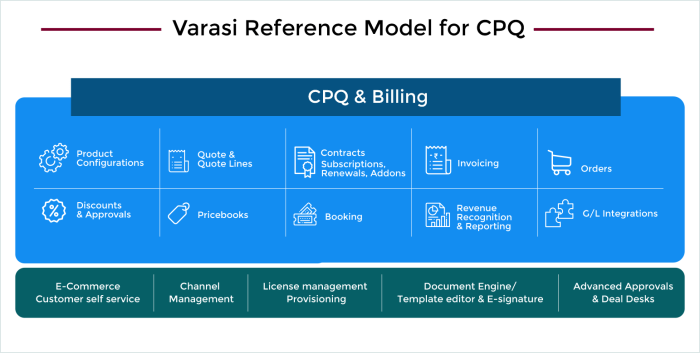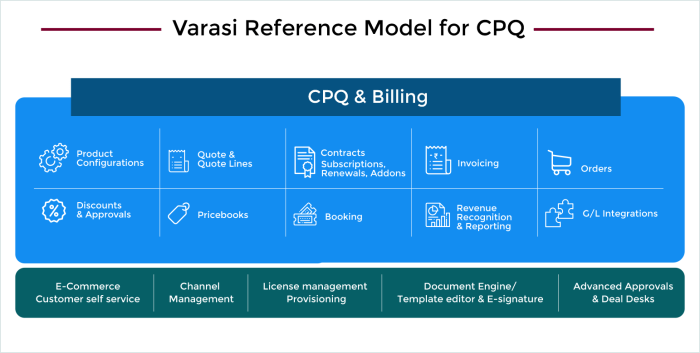Vlocity CPQ vs Salesforce CPQ sets the stage for a fascinating comparison of two powerful Configure-Price-Quote (CPQ) platforms. This in-depth analysis delves into the core functionalities, integration capabilities, pricing models, and implementation considerations of each system. We’ll explore how these platforms differ in handling complex pricing, customization options, and overall scalability, providing a comprehensive overview for businesses seeking the best CPQ solution for their needs.
This comparison will explore the nuances of each platform, allowing readers to understand the strengths and weaknesses of both Vlocity and Salesforce CPQ. The detailed analysis includes comparisons of features, implementation, support, and pricing to help businesses make an informed decision.
Introduction to CPQ
Configure-Price-Quote (CPQ) software is a powerful tool transforming how businesses manage their sales processes. It automates the complex tasks of quoting, pricing, and configuring products, ultimately streamlining the sales cycle and improving profitability. CPQ systems empower sales teams with intelligent tools to deliver accurate and customized offers quickly, driving better customer satisfaction and increased revenue.CPQ solutions are more than just automated quoting tools.
They provide a centralized platform for managing the entire sales cycle, from initial product configuration to order fulfillment. This centralized approach ensures data consistency, reduces errors, and allows for better forecasting and reporting, providing a holistic view of the sales process.
Core Functions of CPQ Systems
CPQ systems typically handle a range of functions, including product configuration, pricing calculation, quote generation, and order management. These functionalities work in concert to streamline the sales process, reduce manual effort, and improve overall efficiency. Accurate and consistent pricing is paramount to profitability and customer satisfaction, and CPQ helps achieve this.
CPQ System Benefits
CPQ systems offer numerous benefits to businesses, including:
- Reduced Sales Cycle Time: Automating the quoting process significantly shortens the time from initial inquiry to order fulfillment. This is particularly important in today’s fast-paced business environment, where speed and efficiency are crucial.
- Improved Accuracy and Consistency: CPQ systems enforce predefined rules and configurations, minimizing errors in pricing, product configurations, and quote generation. This ensures consistent pricing across all deals, and eliminates human errors.
- Enhanced Customer Satisfaction: Personalized quotes and streamlined order processes create a positive customer experience, leading to increased customer loyalty and repeat business.
- Increased Revenue: By enabling faster quoting and more accurate pricing, CPQ helps sales teams close deals more efficiently, ultimately boosting revenue.
Comparison of CPQ Functionality Across Vendors
While most CPQ systems share core functionalities, vendors may differ in their specific implementations and features. Some vendors might excel in specific areas like complex pricing models, while others focus on seamless integration with existing CRM systems. The choice of vendor depends on the specific needs and requirements of each company.
CPQ Software Feature Comparison
The table below highlights typical features found in CPQ software from different vendors. The features can vary in complexity and depth, but the basic functionalities remain consistent.
| Feature | Quoting | Pricing | Order Management |
|---|---|---|---|
| Product Configuration | Allows customers to select and configure desired products, options, and quantities. | Calculates accurate prices based on configured products and options. | Tracks order details, including product specifications and quantities. |
| Quote Generation | Creates professional and customized quotes with clear product descriptions, pricing, and terms. | Applies discounts, promotions, and other pricing rules. | Manages order status and tracks fulfillment. |
| Order Management | Handles order placement and updates. | Handles invoice generation. | Handles returns and exchanges. |
| Integration | Integrates with CRM systems for seamless data flow. | Integrates with accounting systems for automated financial processes. | Integrates with logistics and shipping systems for streamlined order fulfillment. |
Vlocity CPQ
Vlocity CPQ, a cloud-based Configure, Price, Quote (CPQ) solution, stands out from other CPQ platforms. It’s a powerful tool designed to streamline the sales process, improve quote accuracy, and enhance overall sales efficiency. Vlocity CPQ is deeply integrated with the Salesforce platform, leveraging its existing infrastructure and data to create a cohesive sales ecosystem.Vlocity CPQ distinguishes itself through its flexibility and customization capabilities, enabling organizations to tailor the solution to their unique sales processes and product configurations.
This adaptability, combined with its strong integration with other Salesforce products, makes it a compelling choice for businesses seeking a comprehensive CPQ solution.
Unique Selling Propositions
Vlocity CPQ offers several key advantages over competing solutions. It excels in providing a robust, configurable platform tailored to complex sales processes, particularly for businesses with a wide range of products and configurations. Its intuitive interface and user-friendly design allow for easy adoption by sales teams, minimizing training time and maximizing productivity.
Architecture and Key Components
Vlocity CPQ’s architecture is built on the Salesforce platform, leveraging its existing infrastructure for data storage and integration. This architecture facilitates seamless data exchange and reduces the need for complex integrations with external systems. Core components include a powerful configuration engine, a comprehensive pricing and quoting module, and an intuitive user interface. These components work together to automate and streamline the entire sales process.
Integration with Salesforce Products
Vlocity CPQ integrates seamlessly with other Salesforce products, such as Sales Cloud, Service Cloud, and Marketing Cloud. This tight integration enables the sharing of critical data across departments, creating a unified view of the customer. For example, sales representatives can access customer history and service interactions within the CPQ interface, enabling more informed and personalized quoting. This data-driven approach allows for a more effective and targeted sales strategy.
Customization Options
Vlocity CPQ provides extensive customization options, enabling organizations to tailor the solution to their unique business needs. Custom fields, product configurations, and pricing rules can be defined and implemented within the platform. This flexibility ensures that the CPQ solution perfectly aligns with specific industry regulations and company procedures. Customizing the platform for individual business processes allows for a high degree of control over how CPQ is used.
Strengths and Weaknesses
| Feature | Strengths | Weaknesses |
|---|---|---|
| Ease of Use | Intuitive interface, user-friendly design. Reduces training time and boosts team efficiency. | Complex configurations might require significant training for some users. |
| Customization | Highly configurable to meet specific business requirements, allowing for tailored product configurations and pricing rules. | Customization can be time-consuming and may require specialized expertise. |
| Integration | Seamless integration with other Salesforce products. Provides a unified view of the customer across departments. | Integration with non-Salesforce systems may require additional effort. |
| Scalability | Scalable to handle large volumes of data and complex sales processes. Adaptable to growing business needs. | Pricing and licensing structures for larger deployments may be more complex. |
| Pricing | Provides a variety of pricing models to suit different business needs. | The pricing model may not be suitable for all business sizes. |
Salesforce CPQ
Salesforce CPQ (Configure, Price, Quote) is a powerful cloud-based solution for managing the complex process of quoting and pricing products or services. It streamlines the sales cycle, improving efficiency and accuracy in the sales process. This comprehensive platform empowers businesses to deliver accurate quotes quickly, improving customer satisfaction and boosting sales.Salesforce CPQ automates many manual tasks, eliminating errors and reducing the time spent on administrative tasks.
This frees up sales teams to focus on building relationships and closing deals, leading to greater profitability. It’s a robust system that integrates seamlessly with other Salesforce applications, enhancing overall operational efficiency.
Key Features and Functionalities
Salesforce CPQ boasts a wide range of features designed to enhance the quoting process. These features include automated price calculation, configurable product configurations, and the ability to create customized quote templates. The platform also offers robust reporting and analytics capabilities, providing sales teams with insights into their performance and areas for improvement. This allows for proactive management of sales processes and effective decision-making.
Integration with Other Salesforce Applications
Salesforce CPQ integrates seamlessly with other Salesforce applications, such as Salesforce Sales Cloud and Service Cloud. This seamless integration ensures data consistency and facilitates a unified view of the customer journey. Salesforce CPQ leverages data from other applications to provide comprehensive insights into customer interactions, product preferences, and purchase history. This helps sales teams personalize their interactions and tailor quotes to individual customer needs.
Flexibility and Adaptability
Salesforce CPQ’s flexibility allows businesses to adapt the platform to their specific needs. The platform’s configurable nature permits adjustments to product catalogs, pricing rules, and quote templates to match company-specific requirements. This adaptability is crucial for businesses with diverse product portfolios or unique pricing structures. Salesforce CPQ’s customizable features empower businesses to tailor the platform to meet their unique needs.
Pricing Models
Salesforce CPQ’s pricing model is based on a subscription structure, with various tiers to cater to different business needs. The pricing depends on the number of users, features utilized, and the volume of transactions. This tiered pricing structure provides businesses with options to scale their CPQ usage according to their specific needs and budget.
Pricing Structure
| Tier | Description | Typical Features | Estimated Price Range (USD) |
|---|---|---|---|
| Essentials | Basic configuration and pricing rules | Limited user access, basic reporting | $100 – $500 per user/month |
| Professional | More extensive configuration and pricing rules | Advanced user roles, comprehensive reporting | $500 – $1500 per user/month |
| Enterprise | Comprehensive configuration and pricing rules, custom development | Unlimited user access, tailored integrations, complex analytics | $1500+ per user/month |
Note: Pricing is subject to change and may vary depending on specific contract terms and add-on features.
Feature Comparison
Choosing between Vlocity CPQ and Salesforce CPQ hinges on understanding their nuanced feature sets. Both platforms offer robust solutions for managing the complex sales cycle, but their strengths and weaknesses differ. This comparison delves into the core features of quoting, pricing, and configuration, along with customization and user experience.
Quoting Capabilities
Vlocity CPQ and Salesforce CPQ both excel at creating accurate and comprehensive quotes. Vlocity CPQ’s strength often lies in its ability to generate quotes for complex products and services with extensive configurations. Salesforce CPQ is also adept at generating quotes, particularly when dealing with straightforward product lines. A key differentiator is Vlocity CPQ’s focus on quote management for high-value deals, often involving extensive negotiations.
Choosing between Vlocity CPQ and Salesforce CPQ often boils down to specific firm needs. Ultimately, understanding the 5 proven growth strategies for professional services firms, like those detailed in this insightful article 5 proven growth strategies for professional services firms , can help you decide. Factors like pricing complexity and desired customization features will heavily influence the best fit.
In short, Vlocity CPQ and Salesforce CPQ each offer unique strengths for various professional service businesses.
Pricing Management
Pricing scenarios vary significantly, demanding sophisticated solutions. Vlocity CPQ demonstrates a clear advantage in managing complex pricing models, such as tiered pricing, volume discounts, and promotions. Salesforce CPQ handles standard pricing models effectively but may require more configuration for intricate pricing rules. This complexity can impact efficiency in handling high-volume orders. For example, a company selling software with different licensing options and user counts would likely benefit from the more robust pricing models within Vlocity CPQ.
Configuration Capabilities
Configuration is a critical component of CPQ. Vlocity CPQ boasts robust configuration engines, especially for products with a multitude of options and variations. Salesforce CPQ’s configuration engine is well-suited for products with fewer configuration options. The ability to manage and generate complex product configurations is a strong point for Vlocity CPQ, but Salesforce CPQ’s simpler setup might be preferable for companies with less complex product lines.
A retailer selling customizable furniture, with multiple options for materials, colors, and sizes, would likely find Vlocity CPQ’s configuration tools more valuable.
Customization Options
Both platforms offer customization options. Vlocity CPQ’s extensibility allows for more significant modifications to its core functionality. This enables companies with highly specialized needs to tailor the platform to their unique requirements. Salesforce CPQ also provides customization, but the extent of modification often depends on the specific requirements and the need for specific integrations. Companies requiring highly customized features might lean towards Vlocity CPQ for its greater flexibility.
User Interface and Workflows
The user interfaces and workflows of both platforms vary. Vlocity CPQ often offers a more streamlined and intuitive experience for complex configurations. Salesforce CPQ’s interface is generally more user-friendly for simpler scenarios. A company with a straightforward product catalog and sales process might find Salesforce CPQ’s interface more suitable. Vlocity CPQ’s interface is better equipped to handle the complexities of large, intricate product catalogs.
Key Feature Differences
| Feature | Vlocity CPQ | Salesforce CPQ |
|---|---|---|
| Complex Pricing Models | Excellent handling of tiered pricing, volume discounts, and promotions. | Good handling of standard pricing, but less flexible for intricate rules. |
| Configuration Complexity | Superior configuration engine for products with numerous options. | Suitable for products with fewer configuration options. |
| Customization | High degree of extensibility for significant customization. | Customization options are available, but less extensive than Vlocity CPQ. |
| User Experience | Intuitive for complex configurations. | User-friendly for simpler scenarios. |
| Scalability | Well-suited for high-volume sales and complex deals. | Good scalability, but might require more configuration for high-volume orders. |
Implementation and Integration
Choosing the right CPQ platform is crucial, but a smooth implementation and seamless integration with existing systems are equally vital for success. Both Vlocity and Salesforce CPQ offer robust tools for this, but the specifics vary. Understanding these differences and best practices is key to a successful deployment.The implementation process for both platforms involves several key phases, from initial planning and configuration to testing and go-live.
Careful planning, clear communication, and a well-defined project scope are essential. This includes identifying key stakeholders, defining data migration strategies, and mapping out the integration points with other Salesforce applications.
Implementation Process Overview
The implementation process for both Vlocity and Salesforce CPQ platforms typically follows a phased approach. This involves gathering requirements, designing the solution, building and configuring the system, testing, and ultimately going live. Detailed documentation and robust change management are crucial throughout the process.
Technical Expertise Required
Successful implementation and maintenance require specialized skills. A team with expertise in CPQ configuration, Salesforce administration, data migration, and integration technologies is essential. For Vlocity CPQ, specific Vlocity certifications are often a valuable asset, while Salesforce CPQ relies on a broader understanding of Salesforce platform development.
Data Migration Strategies
Data migration is a critical aspect of CPQ implementation. This involves transferring existing product data, pricing information, and configuration options into the new CPQ system. Different approaches exist, ranging from manual data entry to automated data extraction and transformation processes. A well-defined data mapping strategy, ensuring data accuracy and completeness, is vital.
Integration with Other Salesforce Applications
Integrating CPQ with other Salesforce applications like Sales Cloud, Service Cloud, and Marketing Cloud is crucial for a comprehensive solution. Salesforce CPQ, being part of the broader Salesforce ecosystem, often offers seamless integration capabilities. Vlocity CPQ, too, can integrate well, leveraging APIs and other connectors. The chosen integration method should align with the platform’s capabilities and the specific needs of the business.
Best Practices for Integration
Several best practices can optimize the integration process. Firstly, meticulously plan and document the integration points. Secondly, use standardized data formats and validation rules. Thirdly, thoroughly test the integration before going live. Lastly, have a robust support plan in place for ongoing maintenance.
Integration Challenges and Solutions
| Challenge | Solution |
|---|---|
| Data inconsistencies between systems | Develop a comprehensive data mapping strategy and validation rules; utilize data cleansing tools. |
| Integration complexity | Break down the integration into smaller, manageable steps; leverage API documentation and integration tools. |
| Lack of technical expertise | Hire or train personnel with the necessary skills; use readily available resources and support documentation. |
| Maintaining integration over time | Establish a clear process for monitoring and maintaining the integration; track changes and updates to avoid conflicts. |
| Security concerns | Implement appropriate security measures and access controls to protect sensitive data; adhere to industry best practices. |
Customer Support and Training
Choosing the right CPQ platform hinges significantly on the support and training resources available. Both Vlocity and Salesforce CPQ offer comprehensive support, but the specific approaches and depth of resources can vary. Understanding these differences is crucial for organizations planning a CPQ implementation, as robust support and effective training are essential for successful adoption and long-term value realization.
Support Models
The support models offered by Vlocity and Salesforce CPQ differ in their structure and access points. Vlocity often emphasizes a more personalized approach, often with dedicated account managers to guide clients through their implementation and usage. Salesforce CPQ, on the other hand, leans towards a broader, self-service model complemented by structured support channels. The degree of personalization in Vlocity’s model can translate to faster problem resolution and a stronger partnership for customers facing complex implementation needs.
Conversely, the extensive self-service options in Salesforce CPQ provide a quick-response solution for common issues, but may require more proactive engagement for specific, advanced configurations.
Training Programs and Resources
Both platforms offer a range of training materials to equip users with the knowledge to effectively utilize the CPQ platform. Vlocity’s training programs often include interactive workshops, online tutorials, and documentation. Salesforce CPQ provides extensive online documentation, training videos, and access to various online forums and communities. The breadth of training resources offered by both vendors is substantial, but the specific focus and depth of the training materials might vary based on the user’s needs and the complexity of the CPQ implementation.
Community Support
The level of community support for both Vlocity and Salesforce CPQ platforms is significant. Active online forums and communities are available for both platforms, allowing users to connect with peers, share experiences, and find solutions to common issues. Salesforce CPQ’s larger user base often translates to a broader and more active community, providing a wider range of potential solutions and perspectives.
Vlocity’s community, while robust, may be more focused on addressing specific needs related to their platform’s unique functionalities. Both communities are valuable resources for learning and problem-solving.
Third-Party Resources
Third-party resources, such as training providers and consulting firms, are available for both platforms. These resources can provide specialized training, customized support, and additional expertise in navigating complex implementations. Both Vlocity and Salesforce CPQ have a strong ecosystem of third-party partners, offering tailored solutions for specific industry needs or advanced configurations.
Choosing between Vlocity CPQ and Salesforce CPQ can be tricky, especially for solopreneurs navigating the feast-or-famine cycles of independent work. Strategies for managing unpredictable income, like those detailed in solopreneur woes feast or famine survival tactics , are equally applicable to the challenges of picking the right CPQ platform. Ultimately, both Vlocity and Salesforce offer robust solutions, but understanding your specific needs and growth trajectory is key to making the right decision for your solopreneur business.
Summary Table, Vlocity cpq vs salesforce cpq
| Feature | Vlocity CPQ | Salesforce CPQ |
|---|---|---|
| Support Model | Personalized, dedicated account managers | Self-service portal, structured support channels |
| Training Programs | Interactive workshops, online tutorials, extensive documentation | Extensive online documentation, training videos, community forums |
| Community Support | Robust community, focused on platform-specific needs | Large, active community, broad range of perspectives |
| Third-Party Resources | Strong ecosystem of partners | Strong ecosystem of partners |
Use Cases and Examples

CPQ (Configure, Price, Quote) software is revolutionizing sales processes across numerous industries. It streamlines the complex dance of product configuration, pricing, and quoting, empowering sales teams to provide accurate and competitive offers quickly. This efficiency translates into faster deal cycles, increased revenue, and improved customer satisfaction. Understanding the diverse use cases for CPQ is crucial for grasping its potential.CPQ software is not a one-size-fits-all solution.
Its effectiveness hinges on tailored implementation and a clear understanding of how it integrates into existing business processes. Different industries and sales models require specific configurations and functionalities. For example, a software company might use CPQ to configure complex custom solutions, while a retailer might use it for standard product configurations and promotions. Knowing the specific use cases helps companies choose the right CPQ solution for their needs.
Real-World Use Cases
CPQ software is not a niche tool; it’s a powerful engine for streamlining sales processes in a wide array of industries. Its ability to handle complex configurations, pricing rules, and quote generation makes it highly adaptable to various business requirements.
- Manufacturing Industries: CPQ allows manufacturers to configure complex machinery, equipment, or custom-built products with detailed specifications. This ensures accurate pricing based on chosen components, options, and quantities. For instance, a heavy machinery manufacturer can use CPQ to generate quotes for excavators, specifying engine types, attachments, and customization options.
- Software as a Service (SaaS) Companies: CPQ empowers SaaS companies to create flexible subscription packages, with varying features and price tiers. This allows for greater customization to meet customer needs. A SaaS company, offering a suite of marketing tools, can use CPQ to configure custom packages with different feature combinations and pricing tiers.
- Retailers: Retailers can use CPQ to quickly generate quotes for large orders, including product bundles and promotional offers. This efficiency helps them cater to bulk orders and negotiate better prices. A large retail store chain can use CPQ to offer personalized bundles of clothing and accessories, including promotional discounts based on quantity.
- Telecommunications Companies: CPQ helps telecommunication providers offer diverse plans and bundles of services. It allows them to quickly and accurately calculate pricing based on specific data usage, call minutes, or other variables. A telecom company can configure bundles combining different mobile data packages, international calling plans, and add-on services, all priced accordingly.
Benefits of CPQ Implementation
CPQ software goes beyond simply generating quotes; it fundamentally alters sales processes, leading to significant improvements in efficiency and accuracy.
- Improved Sales Efficiency: CPQ automates many of the time-consuming tasks in the sales process, allowing sales representatives to focus on closing deals. This frees up time for relationship building and value-added services.
- Reduced Errors: By automating calculations and validating data, CPQ significantly reduces errors in pricing and quoting. This translates to more accurate offers and higher customer satisfaction.
- Increased Sales Productivity: The automation and streamlining of sales processes through CPQ leads to higher sales productivity. Sales teams can generate more quotes and manage more opportunities within the same time frame.
- Improved Customer Experience: Accurate and fast quotes lead to a better customer experience. Customers appreciate the speed and accuracy of the quoting process, fostering trust and confidence in the sales process.
CPQ Use Cases and Benefits Summary
This table highlights the diverse range of use cases for CPQ and their corresponding benefits.
| Use Case | Benefits |
|---|---|
| Configuring complex products with multiple options | Increased accuracy in quoting, reduced errors, and faster deal cycles. |
| Creating flexible pricing models for subscriptions | Tailored pricing to customer needs, improved customer satisfaction, and increased sales conversions. |
| Generating quotes for large orders and bundles | Efficient handling of bulk orders, streamlined negotiation processes, and improved profitability. |
| Offering customized telecom plans | Personalized plans and packages, increased customer engagement, and enhanced brand image. |
Pricing and Cost Considerations: Vlocity Cpq Vs Salesforce Cpq
Choosing between Vlocity CPQ and Salesforce CPQ often hinges on a detailed understanding of the pricing models and associated costs. These factors significantly impact the total cost of ownership (TCO) and should be carefully evaluated alongside other considerations like features, implementation complexity, and support. A comprehensive understanding of potential hidden costs is crucial for making an informed decision.Pricing structures for CPQ platforms aren’t always straightforward.
Often, pricing is based on a combination of factors like user licenses, features utilized, data volume, and custom development requirements. Evaluating the long-term cost implications is vital for aligning the platform with business objectives.
Pricing Models and Associated Costs
Understanding the various pricing models is fundamental to evaluating the cost implications of each platform. Vlocity CPQ and Salesforce CPQ employ distinct pricing strategies, impacting the overall cost of implementation and maintenance.
Choosing between Vlocity CPQ and Salesforce CPQ can be tricky, but understanding your AEC firm’s specific needs is key. A robust digital marketing strategy, like the one detailed in creating a digital marketing strategy for your a e c firm why its critical , is crucial for showcasing your offerings and ultimately impacting your CPQ selection. Ultimately, the best CPQ solution aligns with your marketing approach and overall business goals.
Therefore, careful consideration of your firm’s needs is vital in making the right choice between Vlocity and Salesforce CPQ.
- Vlocity CPQ Pricing: Vlocity CPQ often utilizes a subscription-based model, with pricing typically tied to the number of users, features accessed, and data volume. Specific pricing tiers might vary based on the scale of the implementation and the specific features required. Additional costs might arise for custom development or integration services. For example, a small business might opt for a basic tier with a limited number of users, while a large enterprise may require a premium tier with more features and scalability.
- Salesforce CPQ Pricing: Salesforce CPQ’s pricing structure mirrors the Salesforce platform’s overall pricing strategy. Licensing costs typically depend on the number of users and the specific features needed. The pricing often incorporates a per-user license cost, with different tiers offering varying levels of functionality. Customizations and integrations may incur additional expenses.
Factors Influencing Total Cost of Ownership (TCO)
Several factors contribute to the overall TCO of a CPQ system. These factors should be thoroughly examined during the selection process.
- Implementation Costs: Implementation costs can vary significantly depending on the complexity of the project, the customization requirements, and the chosen implementation partner. These costs typically include consulting fees, configuration efforts, and training expenses.
- Maintenance Costs: Ongoing maintenance costs include software updates, platform support, and potential data migration efforts. Regular maintenance is vital to ensure the system’s continued functionality and prevent security vulnerabilities.
- Integration Costs: Integrating CPQ with other Salesforce or non-Salesforce systems can influence TCO. The complexity of the integration and the number of systems involved can impact the cost. Poorly designed integrations can lead to performance issues or data inconsistencies, further increasing costs.
- Training Costs: Comprehensive training for sales teams on the CPQ platform is essential for effective adoption. Training costs can include materials, instructor fees, and time spent by internal resources.
Hidden Costs of CPQ Implementation and Maintenance
Beyond the obvious costs, hidden expenses can significantly impact the total cost of ownership.
- Change Management Costs: Implementing a new CPQ system often necessitates a change management process to ensure the sales team smoothly adopts the new platform. Resistance to change or inadequate training can lead to unexpected delays and increased costs.
- Data Migration Costs: Migrating existing pricing and product data to the new CPQ platform can be time-consuming and costly, particularly for large enterprises with extensive data sets.
- Support and Maintenance Over Time: The ongoing cost of support and maintenance often isn’t fully appreciated upfront. This includes the costs associated with addressing issues, implementing updates, and ensuring the system remains compatible with other technologies.
Example Pricing Models and Costs
Pricing models and associated costs are highly variable and depend on several factors, including the scale of the implementation, the features required, and the chosen implementation partner.
Illustrative examples are provided below, but actual costs may differ significantly.
Total Cost of Ownership (TCO) Comparison
| Factor | Vlocity CPQ | Salesforce CPQ |
|---|---|---|
| Implementation Costs (Estimated) | $50,000 – $200,000 | $40,000 – $150,000 |
| Annual Maintenance Costs (Estimated) | $20,000 – $80,000 | $15,000 – $75,000 |
| Hidden Costs (Estimated) | $10,000 – $50,000 | $8,000 – $40,000 |
| Total Estimated TCO (First Year) | $80,000 – $300,000 | $63,000 – $265,000 |
Note: These are illustrative examples and actual costs may vary. Factors such as the size of the organization, specific features required, and chosen implementation partner can significantly impact the final TCO.
Scalability and Performance
Choosing the right CPQ platform for your business hinges on its ability to handle future growth. Both Vlocity CPQ and Salesforce CPQ are robust platforms, but their scalability and performance characteristics differ. Understanding these nuances is critical for long-term success.
Platform Scalability
Vlocity CPQ and Salesforce CPQ are designed for scalability, but their architectures and underlying infrastructure differ, impacting their performance in different scenarios. Vlocity’s architecture, often praised for its flexibility, allows for more granular control over customizations and integrations, potentially enabling quicker scaling to meet evolving needs. Salesforce CPQ, being part of the larger Salesforce ecosystem, benefits from the platform’s extensive infrastructure and support, which can provide robust scaling for established enterprises.
Data Handling and Transaction Volumes
Both platforms can handle large volumes of data and transactions. However, their effectiveness varies depending on the complexity of the configurations and the size of the data sets. Vlocity CPQ excels in handling complex pricing rules and configurations, often preferred by companies with intricate product structures. Salesforce CPQ, with its extensive support ecosystem and established integrations, might be a more suitable choice for organizations with vast existing data volumes and complex workflows.
Performance Metrics
Performance metrics, like response time, processing speed, and transaction throughput, are crucial. Vlocity CPQ, with its focus on customizability, may show variations in performance depending on the specific customizations implemented. Salesforce CPQ, leveraging the Salesforce platform’s infrastructure, generally provides consistent performance across various user loads and data volumes.
Limitations
While both platforms are highly scalable, limitations exist. Vlocity CPQ’s customizability can introduce performance bottlenecks if not carefully managed. Salesforce CPQ’s integration with other Salesforce applications might experience performance issues when encountering extremely complex data relationships or high volumes of concurrent users.
Scalability and Performance Benchmarks
| Feature | Vlocity CPQ | Salesforce CPQ |
|---|---|---|
| Processing Speed (complex pricing rules) | Good, but varies based on configuration | Excellent, leveraging Salesforce infrastructure |
| Transaction Throughput (large order volumes) | Good, suitable for medium to large volumes | Excellent, robust infrastructure supports high volumes |
| Data Handling Capacity (large datasets) | Good, with potential for optimization | Excellent, optimized for handling vast amounts of data |
| Customizability Impact on Performance | Potential for bottlenecks with extensive customizations | Less impact, built on a robust, proven platform |
| Integration with other platforms | Good, requires careful planning | Excellent, robust integration ecosystem |
These benchmarks highlight the potential performance advantages of each platform. Careful consideration of the specific needs and anticipated growth of an organization is essential when selecting the optimal CPQ solution.
Closure

In conclusion, choosing between Vlocity CPQ and Salesforce CPQ hinges on specific business requirements. While both offer robust CPQ functionality, Vlocity often stands out with its specialized features, particularly within the Salesforce ecosystem. Salesforce CPQ, however, offers a more integrated experience for existing Salesforce users. The optimal choice depends on factors like the complexity of pricing scenarios, the existing tech stack, and the desired level of customization.
This comparison provides a clear understanding of the differences, helping businesses select the ideal CPQ solution.






